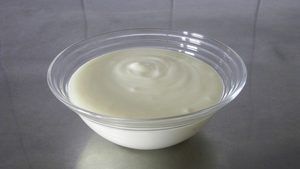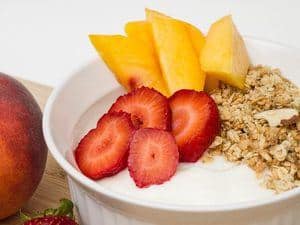The first 12 months is critical for the development of your baby. According to the American Academy of Pediatrics, babies shouldn’t be given any form of solid food for the first six months. After six months, you should notice if the baby is able to sit up without her head drooping. This is a sign that she can now be given some form of solid food, including yogurt.
Babies can eat yogurt as soon they start eating solid food, which is usually at 6 months. Making yogurt yourself at home is best as the store bought flavored yogurts are full of sugar. If buying at the store avoid sweetened varieties and opt for plain natural or Greek yogurt.

The nutrient contents of yogurt makes it a great food for babies. It is a rich source of calcium, potassium, a number of vitamins and protein among others. It contains vitamin B12, which helps red blood cells mature in the bone marrow. It also plays an important role in the metabolism of each and every cell in our bodies and is vital to the functioning of the nervous system. Yogurt also has vitamin A, which plays a crucial role in growth, development, health of the immune system and good vision.
Table of Contents
Ideal Age
The age at which you can start feeding yogurt to your child can vary slightly so you should consult your pediatrician before giving yogurt to the baby. Typically, 7-9 months is the recommended age at which yogurt can be fed. In fact, some pediatricians also recommend yogurt as the first proper food item for babies.
Plain whole milk yogurt is the ideal option for babies, as it contains fat that is useful for the baby’s growth and doesn’t contain sugar. In contrast, most store-bought yogurts that are marketed specifically for children should be avoided. This is because most of them contain added sugar that aren’t good for your child. So, you need to check the list of ingredients on the pack to ensure it doesn’t contain ingredients like fructose, corn sweetener, glucose, cane crystals, molasses, and the like.
How to Start
As stated earlier, one of the earliest signs that your child is ready for solid food is when she can hold her head up. If she reaches out for food that she sees near her or if she weighs between 12-15 pounds (about double the weight at the birth) after six months, then it’s time to introduce her to solid foods. However, once you do feed her yogurt, or other types of semi-solid food, if she either pushes it out of her mouth, then you should hold off for about a couple of weeks before trying again.

Once it’s safe to introduce solid food in the baby’s diet, you can combine certain solid food items such as vegetables and fruits with the yogurt. Initially, you should puree cooked vegetables or fruit and mix it with yogurt. Later, you can add finely chopped cooked vegetables or fruit in the yogurt.
One thing that you need to be careful of is possible allergic reactions. So when you first introduce yogurt to your baby’s diet, do not introduce any other new food item to the diet for at least three days. If there’s an allergic reaction, you will be able to ascertain that it’s due to yogurt in which case, stop feeding your child yogurt and consult your pediatrician. Signs of allergic reactions may include skin rashes, a swollen tongue or lip, hives, diarrhea or vomiting, coughing, or breathing issues.
Tips
Yogurt vs Milk
There are two main reasons why it’s fine to feed a baby yogurt but not regular milk before the the age of one.
- 1Introducing whole milk in a baby’s diet before the age of one can result in it replacing breast milk, which is essential for the wholesome growth and development of the child. Breast milk contains the perfect balance between fat, protein and vitamins. It has antibodies that strengthen the child’s immune system and ward off viruses and bacteria. It also plays a vital role in the brain development in a child, with studies showing that babies who are exclusively breastfed for the first six months and in combination with other food items for one year have higher IQ scores as they grow up.
- 2The process of making yogurt includes the introduction of starter culture to enable fermentation. This helps in breaking the lactose component in milk and makes yogurt considerably easier to digest as compared to whole milk. This also protects the child in case they are lactose intolerant or are susceptible to milk protein allergy.
Homemade Yogurt
You can give your child whole milk yogurt brought from the store. However, if you want to have complete control over what you feed your child (and if time permits), then you should consider making yogurt at home. It’s a really simple process and the results are yummy. You can always make a separate batch with honey, vanilla, maple syrup, and other ingredients for the adults.

What You Need
Recipe
- 1Sterilize the glass cups or containers along with the saucepan with boiling water.
- 2Pour the milk into the saucepan and heat it to 175-180 degrees Fahrenheit. But make sure that the milk doesn’t start boiling.
- 3Now allow the milk to cool down to about 95-100 degrees. Use a thermometer for accuracy. A candy thermometer will be sufficient, but it will require you to constantly be on top of it. A digital thermometer with an alarm is more efficient, as it will alert you the moment the temperature reaches 180 degrees in the previous step and 100 degrees in this step.
- 4In a glass bowl, take about 100 ml of the cooled milk and add the starter culture or probiotic capsules. Stir well till it’s completely mixed.
- 5Pour this mixture back into the saucepan with the rest of the cooled milk and thoroughly mix it.
- 6If you want the process of making yogurt at home to be even simpler, then instead of store bought culture or probiotic capsules, use pre-made yogurt. It could be yogurt that you have saved from the previous batch you made or store bought yogurt. However, if you opt to use yogurt bought from the store, then make sure it contains live active yogurt cultures such as L. Bulgaricus, S. Thermophilus, or L. Acidophilus.
- 7Place this saucepan with its lid securely fixed into the oven and cover it with towels. The oven should be at around 110 degrees. For this, keep the oven light switched on, as it helps keep the temperature steady. You might have to experiment a bit to check if the standard 40 watt bulb in the oven is sufficient to keep the temperature steady or if you need a 60 watt bulb. This part is extremely important as the cultured milk needs the steady heat to ferment and turn into yogurt.
- 8Let it rest for about 10 hours and then check the taste. Since the yogurt is meant for your baby, you don’t want it to be too sour. For adults, you could let it ferment for up to 24 hours as the longer it ferments, the tangier it tastes.
- 9After removing the saucepan from the oven, check if there’s a layer of whey on top. Whisk this into the yogurt for a creamier consistency.
- 10Fill up the sterilized glass containers with the yogurt, cover them with cheesecloth and tie around the mouth of the container and refrigerate them.
- 11This batch of yogurt should be consumed within two weeks.
Yogurt Maker
To make the process simpler you can use a yogurt maker. These devices ensure that temperature remains steady while the cultured milk is fermenting. Some yogurt makers, like the Euro Cuisine YMX650 yogurt maker, are also equipped with a timer feature, which allows you to set a specific time after which the device automatically shuts down.

Conclusion
Plain yogurt without added sugar is an excellent addition to a baby’s diet. It contains a host of nutrients that are necessary for the child’s development and none of the issues are related to milk. In fact, the culturing of yogurt makes it easier to digest.
Yogurt is versatile, so your baby can have it plain and in combination with vegetables and fruits, once it’s ready to have more solid food. Mixing or combining vegetables and fruits with yogurt also makes it simpler to introduce new types of solid food to a child. However, you need to introduce new food items slowly into the child’s diet. This will ensure that you can keep a track of any allergic reactions from specific food items. Also, just because the pediatrician has suggested feeding your baby yogurt, doesn’t mean you force them to eat it, only feed it to them if they like it.
Resources:
Healthy Children
NCBI
Child Care Finder
